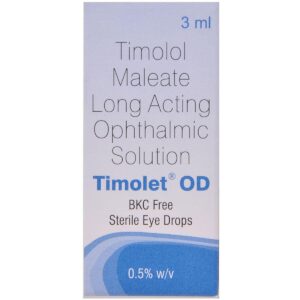PILOCARPINE + TIMOLOL MALEATE
Pilocarpine: Pilocarpine is a medication primarily used to treat conditions like glaucoma and dry mouth. It is classified as a cholinergic agonist, which means it stimulates the cholinergic receptors in the body.
In the case of glaucoma, pilocarpine works by constricting the pupil of the eye (miosis) and increasing the outflow of aqueous humor, reducing intraocular pressure. By reducing pressure within the eye, it helps prevent optic nerve damage and loss of vision.
Pilocarpine is also used to stimulate salivation in people with dry mouth syndrome, a condition known as xerostomia. It increases saliva production by stimulating the salivary glands.
The recommended doses of pilocarpine vary depending on the condition being treated. For glaucoma, the usual dose is one drop of pilocarpine 1-4% solution in the affected eye(s) two to four times a day. The dose may be adjusted by a healthcare professional based on the response.
For xerostomia, a typical starting dose is pilocarpine 5 mg tablets three times a day, with the dose possibly increased up to a maximum of 10 mg four times a day.
Some common side effects of pilocarpine include blurred vision, eye irritation, headache, eye pain or discomfort, increased sweating, increased salivation, and nasal congestion. These side effects are usually mild and go away on their own. However, if they persist or worsen, it is important to consult a healthcare professional.
It is worth mentioning that pilocarpine can also cause systemic side effects such as diarrhea, dizziness, low blood pressure, and allergic reactions, although these are less common.
As with any medication, it is important to follow the prescribed dose and consult a healthcare professional if there are any concerns or questions about its use.
Timolol Maleate: Timolol Maleate is a drug that belongs to a class of medications known as beta-blockers. It is primarily used in the treatment of certain eye conditions and high blood pressure.
In ophthalmology, Timolol Maleate is commonly prescribed to reduce intraocular pressure in patients with open-angle glaucoma or ocular hypertension. By decreasing the production of fluid in the eye and improving its drainage, Timolol helps to lower the pressure within the eye, thus preventing optic nerve damage and vision loss.
The exact mechanism of action of Timolol Maleate involves blocking specific beta-adrenergic receptors in the body. By binding to these receptors, Timolol reduces the effects of adrenaline and other stress hormones, causing a decrease in heart rate and blood pressure.
Timolol Maleate is available in various forms, including eye drops, oral tablets, and a gel-forming solution. The dose and frequency of administration depend on the condition being treated and should be determined by a healthcare professional. For glaucoma and ocular hypertension, the usual starting dose is one drop of 0.25% Timolol eye solution in the affected eye(s) twice daily. The dose can be adjusted based on the patient’s response.
As with any medication, Timolol Maleate may cause side effects. Common side effects of the eye drops include eye irritation, burning or stinging sensation, dryness, blurred vision, and systemic effects such as headache, dizziness, and fatigue. Some individuals may experience allergic reactions like itching, redness, or swelling around the eyes, face, or throat. Additionally, systemic absorption of Timolol can sometimes lead to cardiovascular and respiratory effects such as decreased heart rate, low blood pressure, and difficulty breathing.
It is important to note that Timolol Maleate may interact with other medications, so it is crucial to inform your healthcare provider about all the medications you are taking, including over-the-counter drugs, supplements, and herbal products.
Overall, Timolol Maleate is a widely used medication for the treatment of glaucoma, ocular hypertension, and high blood pressure. It effectively reduces intraocular pressure and helps prevent further vision loss when used as prescribed. However, it is essential to consult with a healthcare professional to determine the appropriate dosage and monitor any potential side effects.

